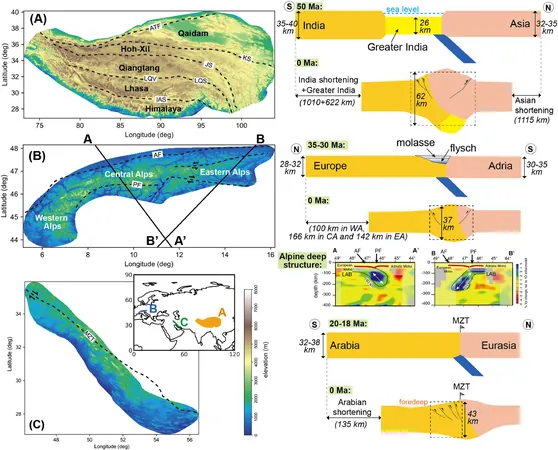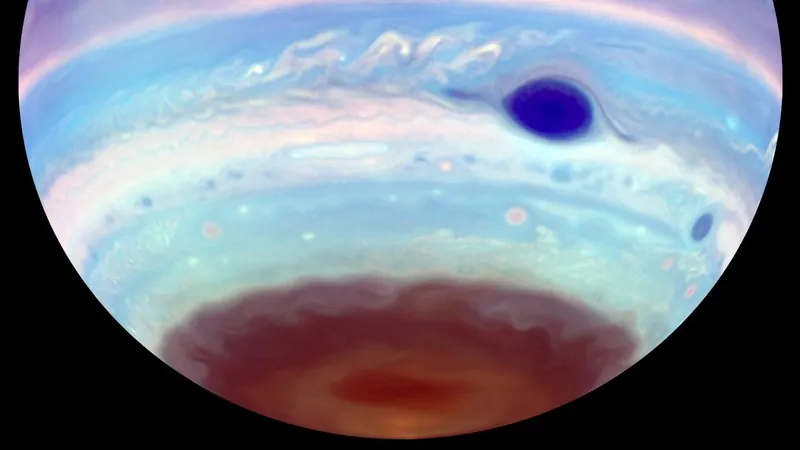
Stunning Revelation: Himalayas' Formation May Have Wiped Out 30% of Continental Crust!
2024-11-28
Author: Jia
Stunning Revelation: Himalayas' Formation May Have Wiped Out 30% of Continental Crust!
Recent groundbreaking research has shed light on the colossal impact of plate tectonics on Earth’s continental crust, revealing that the formation of the majestic Himalayas, along with the European Alps and the Zagros Mountains, has been more destructive than previously imagined. In fact, scientists estimate that over 30% of continental crust in these collision zones has been lost to the mantle, significantly shaping the geology of our planet.
The Earth’s continents are in a constant slow dance, moving and colliding due to the forces of plate tectonics. This dynamic process leads to areas of crustal expansion and, crucially, collision—where immense temperatures and pressures reforge the crust’s composition. As two continental plates collide, towering mountain ranges emerge as physical manifestations of a thickened crust.
According to a new study published in Earth and Planetary Science Letters, researchers from Monash University, led by Dr. Ziyi Zhu, devised a mathematical model to analyze the fate of continental crust during such collisions, specifically focusing on the Himalaya-Tibetan Plateau, the European Alps, and the Zagros Mountains, which date back to the Cenozoic era (the past 66 million years).
Dr. Zhu likens the process to squeezing a chocolate bar: as the chocolate compresses (shortening horizontally), it forms a pile (thickening vertically). This means that during these continental love-taps, not only is crust thickened, but some crustal material is extruded sideways or eroded away. If the mass of the crust is preserved, any discrepancy points to material that likely sinks into the mantle.
The startling finding? The Himalaya-Tibetan Plateau and the Zagros Mountains may have lost a staggering 30% to 64% of their original crust, while the European Alps could have seen up to a 50% loss. To put this into perspective, the rate of crust disappearing into the mantle is twice that of erosion caused by surface processes—a stark revelation for geologists and climate researchers alike.
Delamination, a process where the denser lower continental lithosphere sinks into the mantle, is identified as a key mechanism driving this recycling of crustal materials. The study highlights the formation of specific rocks within these mountain ranges, shaped by deep geochemical processes, that bear witness to the intense heat and pressure conditions during this enigmatic period.
Moreover, this rapid crustal recycling has profound implications for climate patterns as well. The drastic uplift of the Himalayas corresponds with a dramatic increase in monsoon rainfall about 22 million years ago, linking geological evolution to significant shifts in Earth’s climate systems.
The geological history of continental collisions is extensive, with evidence suggesting that similar processes of crustal loss took place during the formation of supercontinents millions of years ago. For instance, the collision between East and West Gondwana around 500 million years ago birthed the expansive Transgondwanan Supermountains.
This research not only deepens our understanding of how dramatic geological formations such as the Himalayas affect the Earth's crust but also suggests that a significant portion of our planet’s crust has been “recycled” into the mantle throughout its history—potentially altering the mantle's composition over the eons.
This eye-opening inquiry into the Earth's crustal dynamics serves as a reminder of the intricate relationships between geological processes and climate systems, unveiling the hidden stories of the planet beneath our feet.
Stay tuned for more astonishing discoveries that redefine our understanding of Earth’s geological history!



 Brasil (PT)
Brasil (PT)
 Canada (EN)
Canada (EN)
 Chile (ES)
Chile (ES)
 España (ES)
España (ES)
 France (FR)
France (FR)
 Hong Kong (EN)
Hong Kong (EN)
 Italia (IT)
Italia (IT)
 日本 (JA)
日本 (JA)
 Magyarország (HU)
Magyarország (HU)
 Norge (NO)
Norge (NO)
 Polska (PL)
Polska (PL)
 Schweiz (DE)
Schweiz (DE)
 Singapore (EN)
Singapore (EN)
 Sverige (SV)
Sverige (SV)
 Suomi (FI)
Suomi (FI)
 Türkiye (TR)
Türkiye (TR)